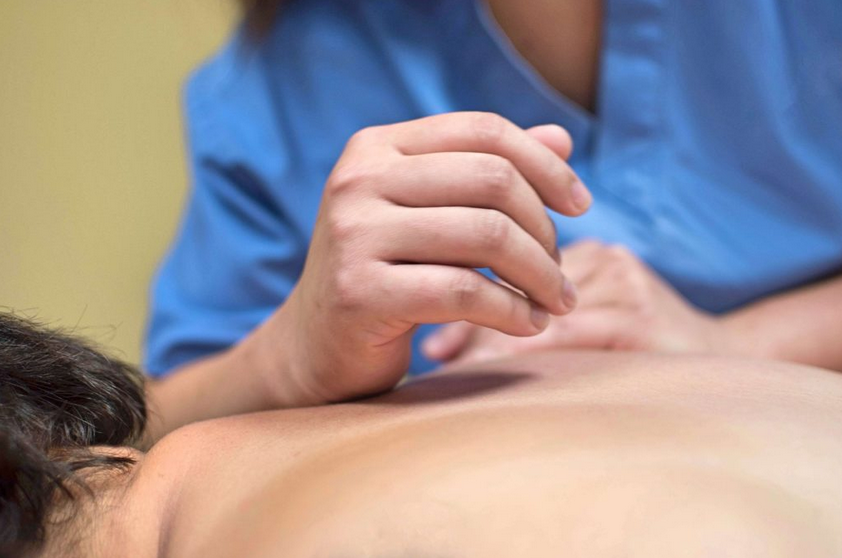Following an accident or surgery, patients need a safe place to heal. A massage therapist can create an atmosphere of trust and safe touch, to allow for deep healing. Massage therapy can help heal scar tissue on physical as well as emotional levels. From minor cuts to surgery scars, massage therapy can benefit all types of scar tissue.
Scar Tissue Issues
There’s a common misconception that scar tissue is inevitable—that it’s impossible to change or heal. In truth, scar tissue is part of the living matrix. All tissues are made up of the same elements, such as collagen and elastin. Cells deliver nutrients and release waste from all tissues in the body, including scar tissue. As such, scar tissue can be revitalized through self-care, including receiving massage therapy.
So how is scar tissue different than regular tissue?
- Scar tissues do not have melatonin, meaning they cannot tan but will rather burn. Always put sun block on your scars!
- Collagen fibers in scar tissue to not grow in the same direction as the original tissue, leading to discoloration and uneven texture.
A massage therapist sees opportunity where others might shy away from scar tissue. Therapists can also speak with clients about daily stretching, self-massage, and lifestyle choices that will benefit all types of tissue, including scar tissue.
How Massage Helps Heal Scar Tissue
To understand how massage therapy can kindle scar tissue healing, let’s review how the body repairs wounds. This is done in four stages:
- Acute Stage. The body creates stability through clotting and chemotaxis. In other words, a temporary tissue matrix closes the wound, and immune cells are attracted to fend off infection.
- Inflammatory Stage. Immune cells remove dead cells and tissue, priming the area for restoration. The area appears red and inflamed. Typically, this stage lasts for a couple days.
- Repair Stage. The temporary clotting matrix is replaced with scar tissue, thereby restoring partial tissue structure and function. The area will look raised and scabbed, and may feel warm and/or numb. This period lasts for 2-10 days.
- Remodeling Stage. Cell density and metabolic intensity decrease, while nerves heal, restoring sensation. The scar may be itchy or sensitive, and appears purple, then white, and finally approaches your natural skin tone. This stage lasts from 10 days following the incision to up to two years later! Massage therapy will be most effective during this period.
Repaired scar tissue strength improves from 25% to 80% during this process, as collagen changes occur. Scar appearance depends partially upon genetics, as some families have more obvious scars than others. Additionally, scars on taut tissue (such as the knee cap) are typically more visible than those on more fleshy areas (such as the buttocks).
Because tissue is still in repair early on, it is best to wait until 2 weeks after a surgery or accident to massage scarred areas.
Oftentimes, scar tissue has reduced lymph return and fewer capillaries (to deliver blood). While formal research in this area is limited, manual manipulation may spur the creation of blood vessels through local stimulation. Massage creates a temporary inflammation, followed by remodeling and increased waste removal. This could encourage the growth of new blood vessels (angiogenesis), further improving circulation and healing. Here are a few more physiological benefits of scar tissue massage:
- Drainage of excess fluid.
- Increased feeling in the area, and decreased tingling, numbness, or soreness.
- Improved range of motion and flexibility, so the scar doesn’t feel as “tight.”
- Decreased scar tissue buildup.
- Promotion of collagen remodeling through application of pressure.
Improved scar appearance may also accompany manual manipulation. Patients can assist in scar-tissue healing through self-massage, as outlined in this handout from the Moffitt Cancer Center.
Emotional Benefits of Scar Tissue Massage
A massage therapist can help clients release long-held pain following major surgeries or accidents. As Peter Levine and others have pointed out, pain is not just experienced on the physical level. Our minds also write pain patterns into the body through our emotional experiences. A traumatic event is written into the nervous system’s long-term memory through muscular holding patterns, for instance. (For more on the fascinating intersection of psychology and physiology, we recommend reading Levine’s works, such as In an Unspoken Voice: How the Body Releases Trauma and Restores Goodness.)
For instance, LMT Pete Whitridge writes about a client who experienced neck and shoulder pain, as well as difficulty breathing, following a surgery 8 years prior. Following an accident, this client had surgery to repair a collapsed lung. Her scar ran 18 inches parallel to her fifth and sixth ribs on her left side. While she was in good health and practiced yoga, this client couldn’t breathe comfortably. During massage, the client discovered that she had been imagining that she couldn’t move her left ribs because she thought it would hurt. Manual palpation revealed that the scar tissue was strong and pain-free. The client was able to experience her own healing, thereby releasing her limiting thoughts about recovery. Her breathing and range of motion improved following this massage therapy session.
Are you called to a healing profession? Do you feel a tingle of wonder when considering how a gentle touch can release trauma? If so, consider applying for our massage therapist school. Our in-depth, comprehensive program culminates in the opportunity to earn your massage therapy license according to Oregon’s requirements. (Each state has its own requirements for massage therapy certification or licensure.) East West College students have the opportunity to practice their craft through our on-campus clinic. With hands-on experience, and thorough classes taught by experienced LMTs, East West College graduates are well-prepared for successful careers in the healing art of massage therapy.




